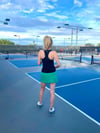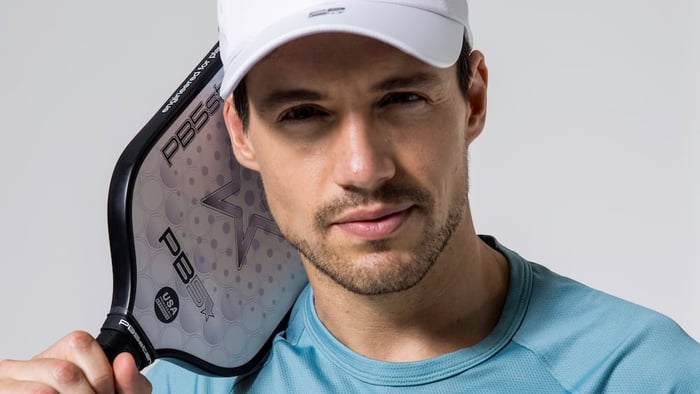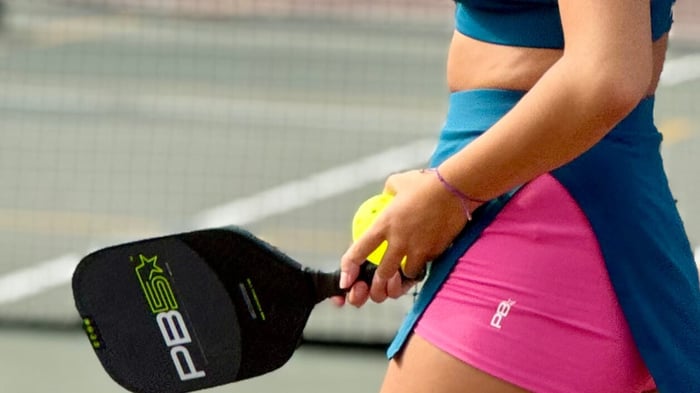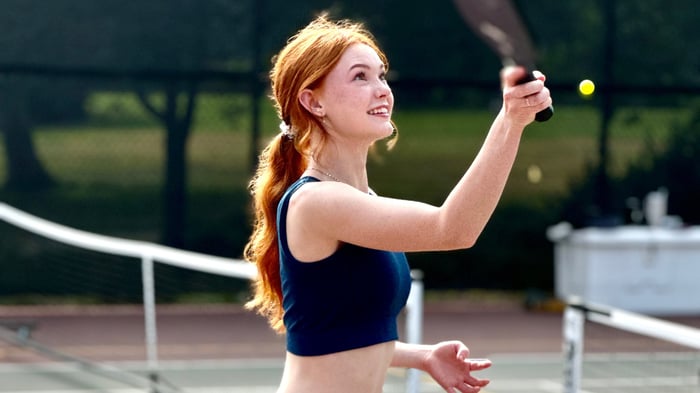Key takeaways:
Left-handed players flip the court dynamics. Their angles, spin, and shot patterns can feel unfamiliar—but once you recognize them, you can adjust before the rally slips away.
Target the backhand to limit their options. Most lefties are strongest on their forehand side—so hitting deep to their right can take away their best shots.
Gear makes a difference when your game stretches wider. From paddles that hold up under pressure to apparel that won’t fight your movement, make sure your setup supports your strategy.
Most pickleball players train against right-handed opponents. You've built your instincts around their habits—the spin on their serves, the reach of their forehands, the angles they favor from the kitchen line. But when you face a left-handed player, that muscle memory doesn't line up the same way. The ball curves differently. Court positioning shifts. And the patterns you rely on suddenly feel less reliable.
This guide walks through how left-handed play changes the game, what it means for your positioning and decision-making, and how to adapt—whether you're facing a lefty or teaming up with one. With the right awareness and a few key adjustments, you can stay in control and use those differences to your advantage. And when your movement needs to match those shifts, PB5star gear is built to support quick footwork, clean resets, and full-court coverage—no matter which side of the net you're on.
Recognizing how left-handed players change the court
When you face a left-handed player, you're not just flipping the same strategy to the other side of the court. You're navigating different angles, positioning patterns, and timing challenges.
Their forehand sits on the opposite side from what you're used to. That single shift changes how the ball moves, where it lands, and what part of your court gets tested most often—especially in fast exchanges or transition play.
Here's how those differences show up:
Serves bend away from your forehand. Left-handed spin often pulls the pickleball into your backhand side. If you're right-handed, that's a tougher return angle—especially if you're not expecting it.
Crosscourt dinks follow an unfamiliar path. Most players practice righty-to-righty dinks. Against a lefty, the ball floats in on a different diagonal, often landing in spots that feel harder to reach or reset.
Third-shot drops target different coverage zones. A lefty's drop may land closer to you than your partner, pulling you forward earlier and widening the gap in the middle if you don't coordinate movement.
Court coverage looks mirrored. In doubles, right-handed players usually favor the left half of their zone. Lefties tend to do the opposite, which means they take more middle balls from their right side. If you're not reading that shift, your positioning can fall out of sync during serve returns and kitchen-line play.
These patterns aren't harder to handle but catch you off guard if you're not used to them. In pickleball, even a split-second delay can be the difference between staying at the point or giving it away.
If you don't get much practice against left-handed players, it helps to work on the movements that mimic those matchups. Lateral footwork resets from awkward angles and recovering after being pulled wide—those skills make the court feel familiar again, even when the shot patterns aren't.
Adjusting your strategy against left-handed opponents
Knowing how a left-handed player changes the game is a great starting point—but what you do with that knowledge makes the difference.
Left-handed players bring angles and patterns most right-handed players rarely see. But you don't need to change everything about your game to keep up. A few smart adjustments—in your positioning, shot placement, and movement—can help you stay steady, even when the court feels unfamiliar.
It's all about being more aware and responding with purpose. Here's how to modify your pickleball play with a left-handed opponent or partner.
Adjust your return position
Most righties are used to serves that bend into their forehand. Against a lefty, that spin flips—now it's heading toward your backhand or sliding off the sideline entirely.
So, shift your return position slightly toward your backhand side. It doesn't need to be dramatic—just enough to give yourself a better angle and more time to react. You'll feel more balanced and less rushed right from the first shot.
Hit to their backhand
Every pickleball player has a side they'd rather hit from. For most lefties, that's their forehand on the left side of the court.
Aim your shots toward their right side—their backhand zone to take that away. A well-placed serve or return to that corner can make them choose between stepping around (and giving up court space) or sending back a softer, more defensive shot. Keep targeting that area and you'll start controlling the tempo of the rally.
Watch for sharper crosscourt angles
Left-handed players love that tight crosscourt dink, and if you're not ready for it, they'll pull you way off the court before you even realize it.
To stay in position, keep a slightly wider stance at the kitchen line and shift a bit toward the sideline if you see them lining up that angle. Stay low and engaged—you don't need to cover everything, just react early and keep your balance.
One extra tip: watch their paddle. If it opens up early or their stance shifts outward, there's a good chance that angled dink is coming.
Recover with purpose
The more ground you cover, the more important your recovery movement is. If you're stretched out wide or chasing down a low drop, getting back into position quickly sets you up for the next shot.
Don't rush blindly to the middle. Instead, recover to a spot that gives you the best chance to handle their next angle—not just the default center position. Small, balanced footwork makes all the difference. The more consistently you can reset between shots, the less pressure you'll feel on every swing.
Building a winning partnership with a left-handed teammate
Playing with a lefty changes how your team flows. With one paddle on each side of the pickleball court, you can take control of the middle, create angles your opponents aren't used to, and cover more space without overreaching.
But that advantage doesn't just happen on its own. You have to be intentional about how you line up, communicate, and train together.
Start with positioning that makes sense
One of the easiest ways to set yourselves up for success is to put the left-handed player on the left and the right-handed player on the right. That keeps both forehands facing the middle—where most of the action happens.
When both players have their forehands facing the middle, it gives you more control in the busiest part of the court. You’ll be better positioned to attack soft returns, step in to take a ball early, and stay on the offensive during fast exchanges at the kitchen line. It also makes those “who's got it?” moments in the middle less confusing—because you're both already set up to cover that space with your stronger side.
Talk it out—before, during, and between points
Even with perfect positioning, miscommunication can throw everything off. Lefty-righty teams sometimes hesitate over who takes the shot—especially on returns, poaches, or anything hit between you.
Use short, clear cues like "yours" or "mine" during rallies. In faster moments, hand signals or paddle taps can help too. But don't just rely on in-game chatter—talk between points. If something's not working, adjust it. Don't need to over-communicate, just try to be on the same page.
Practice patterns that show up in matches
The best lefty-righty teams don't just figure things out on the fly—they drill specific combos to be ready when the moment comes.
Try patterns like:
Drop, poach, recover: One of you sets up the soft third shot, the other steps in for the finish, and then you reset your positioning.
Middle-ball coverage drills: Practice who takes the ball when it lands between you—and make that decision second nature.
Return + third-ball timing: Work on clean transitions from deep returns into structured attacks.
The more reps you get, the less you hesitate during a match. You won't be second-guessing who's covering what—because you've already worked it out.
Mix up formations when it makes sense
Don't just play the same setup every time. Lefty-righty teams can benefit from changing formations—especially if it helps create better angles or disrupt your opponent's rhythm.
Try stacking (starting both players on one side of the court) to get your preferred player into position after the serve or return. Or go with staggered movement as you transition from the baseline. So one of you is set up to poach while the other provides coverage.
These tweaks take practice, but once they click, they give your team more flexibility—and make it harder for opponents to predict what's coming next.
Final take: sharpen your strategy, expand your game
Left-handed matchups change the way the court plays. The angles shift, the spacing feels different, and your usual patterns might not land the same way. But once you know what to expect, you can adjust early and play more confidently. If you're up against a lefty, small tweaks to your positioning and shot placement can take away their best options. If you're on the same side of the net, you've got a real chance to control the middle and keep opponents guessing—especially if you've practiced how to move and communicate as a team.
No matter who you are playing, you want shoes and clothing that keep up. The PB5 Court2 Shoes are built for lateral support—they grip well and help you stay balanced when you have to plant and shift fast. Pair them with PB5star’s performance apparel and gear, designed to keep you comfortable, confident, and focused through every match.







